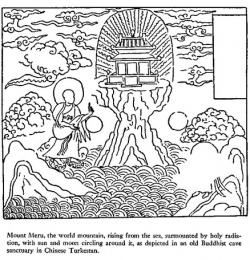Mount Meru
Mount Meru or Mount Sumeru (Skt. sumeruparvata; Tib. རི་རབ་, Wyl. ri rab) is a mountain square in shape with four sides, larger at the top than at the bottom.
It is 80,000 yojanas (450,000 km) high. It lies at the centre of the world.
Around it are seven freshwater lakes separated by seven rings of golden mountains.
Outside, in a great salty ocean, are the four continents and eight subcontinents (two out at sea, left and right of each of the continents).
We humans live on the southern continent called 'Jambudvipa'.
This entire world system is surrounded by a ring of iron mountains.
The universe is made of many such worlds.
For instance, a trichiliocosm is composed of one billion such worlds.
At the top of Mount Meru is the lowest abode of the gods of the Desire Realm (the terraces of the Four Great Kings).
In the space above are the five other abodes of the gods of the Desire Realm and those of the gods of the Form Realm.
It rests on the universal golden basis. Usually it is said that the pretas live on its sides, in cavities between the limit of the waters down to the golden basis.
Its four sides are made of four different precious substances: the south of lapis-lazuli, the west of ruby, the north of gold and the east of crystal (Tib. shel).[1]
Since we are living on the southern continent of Jambudvipa and the southern side of Mount Meru is blue, this explains why the seas around and the sky above us are blue.
The shine of the blue lapis-lazuli reflects on the marine waters in front.
Upon hitting the surface it reflects and appears in the space above.
So rather than there being something blue above us, the space appears blue because of the reflection of the lapis-lazuli of Mount Meru's southern side. Similarly the oceans and the sky are respectively red, yellow and white in the West, North and East directions of Mount Meru.
Footnotes
Further Reading
- Robert Beer, The Handbook of Tibetan Buddhist Symbols (Boston: Shambhala, 2003), pages 83-84.
- Jamgön Kongtrul, Myriad Worlds (Ithaca: Snow Lion, 1995), pages 109-110.
Source
People of all times from around the world have stood in awe when faced with majestic mountains. From these sublime experiences have come myths about great mountains as homes of the gods, as stairways to the heavens, as pillars of the earth.
One mountain range in particular inspired this kind of awe, wonder and devotion - the vast Himalayas.
The Tibetans and the Hindus especially held the great Himalayan mountain range as sacred.
Its grand peaks seemed to reach beyond the profane human realm and stretch up, touching the divine realm of the gods, so the Tibetans and Hindus saw the mountains as a means of transition between both the human and heavenly worlds.
The mountains were created, myth tells us, by the god Indra.
A huge herd of flying elephants had displeased him, so he punished them by cutting off their wings and they turned into the Himalayas. The mountains were important to all of the gods for they all made sacrifices there.
They were especially significant to the god Shiva, however, whose paradise was on Mount Kailas and whose deep meditation upon the mountain ensured the continued existence of all things.
The most sacred mountain of the whole Himalayan range though was most definitely Mount Meru.
As we have discussed, Mount Kailas is the home of the great god Shiva.
Well, Mount Kailas is an actual Himalayan mountain in the Ngari region of Tibet. It rises 22,000 feet high from the edge of the Tibetan Plateau and is highly inaccessible. It is Mount Kailas then that is the physical embodiment of Mount Meru for the Buddhist and Hindu peoples.
Mythical Mount Meru was thought to be the axis of the universe, sitting at the centre of the Himalayas.
Myths say that Meru rested on the hood of the coiled primeval cobra Vasuki, who, it was said, caused earthquakes when he yawned. It was also believed that the whole world would be devoured by this ancient snake at the end of the present age, world cycle.
The Hindus and Buddhists both regarded Mount Meru as sacred for it was thought to be the centre of the cosmos and supported all of the spheres of existence, from Brahma's divine city of gold at its peak, to the seven netherworlds at its base, and especially as the source of the sacred Ganges river.
They said that Mount Meru's slopes were studded with glittering gemstones and were thick with trees heavy with delicious fruit. Its peaks were rimmed with gold and a huge lake encircled it.
The divinity of this mountain is reflected in the religious objects of worship, yantras, of these peoples for the mountain is symbolized in their conical shape. Indeed, this majestic mountain inspired much awe in those who beheld it.
How could they not think it supported the cosmos and was home to a great god?
It commanded respect in its sublime beauty and the peoples of the region responded by holding it most sacred.

